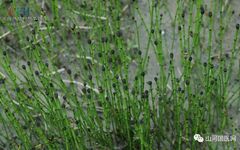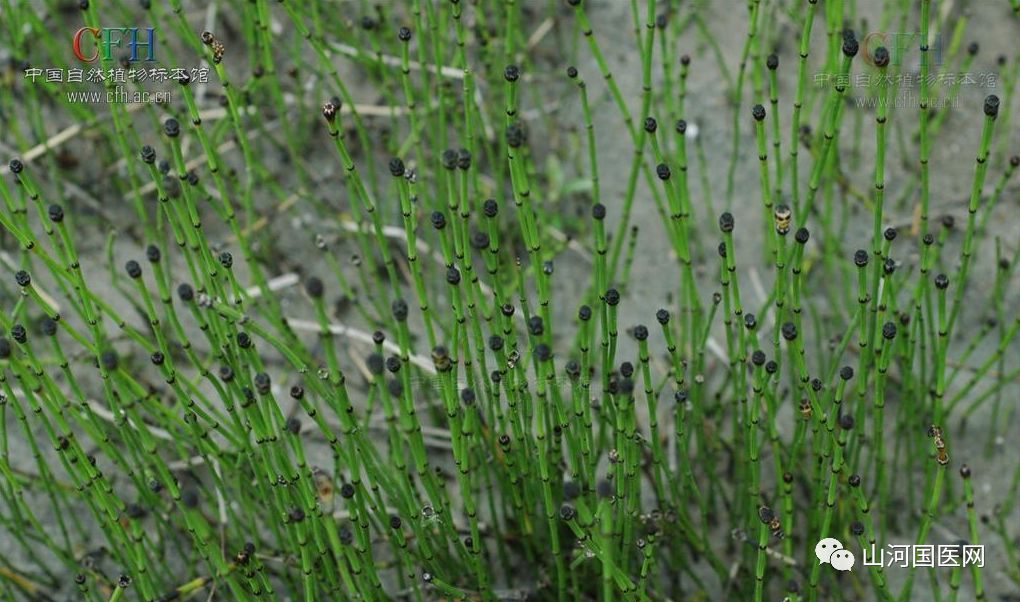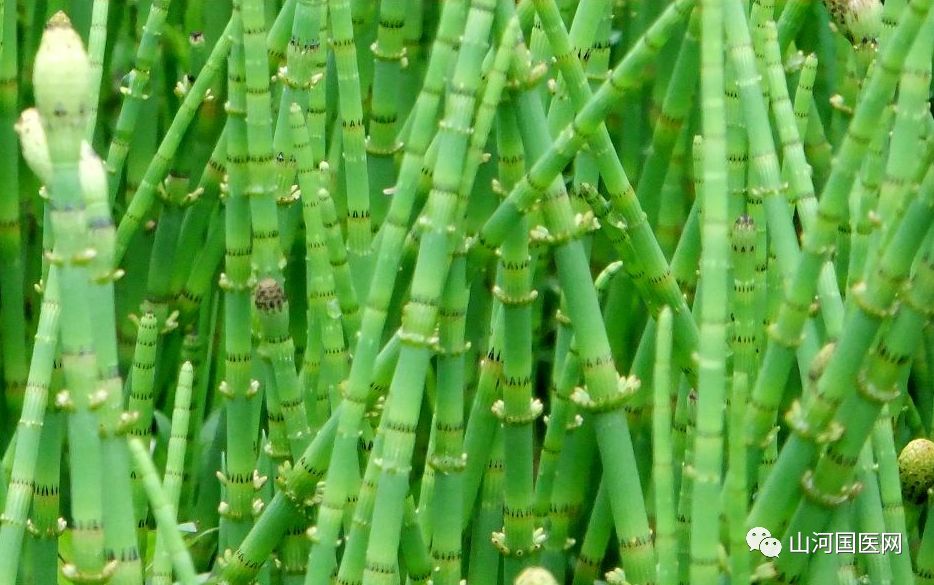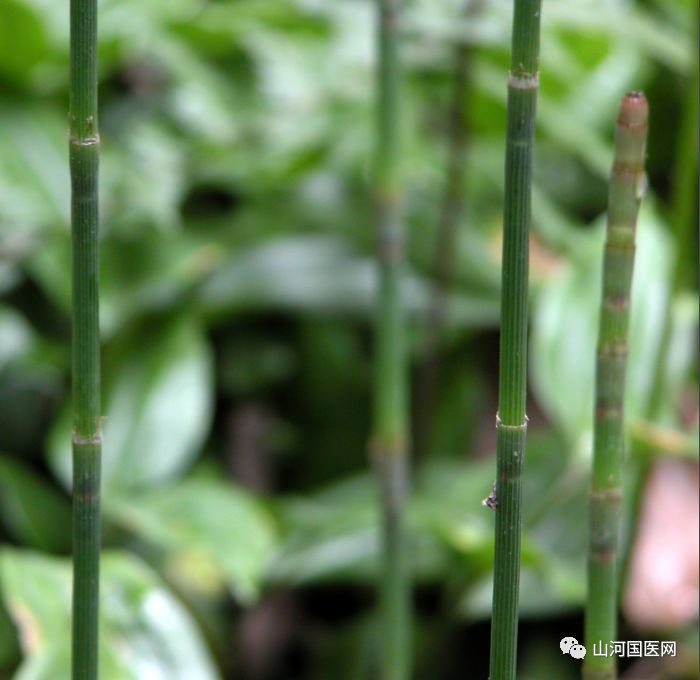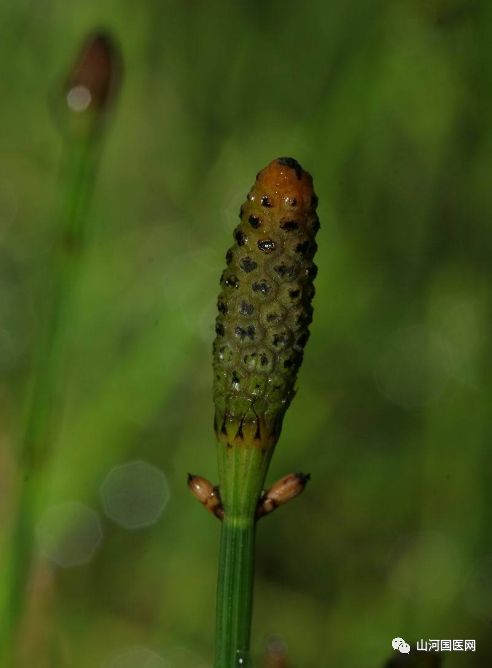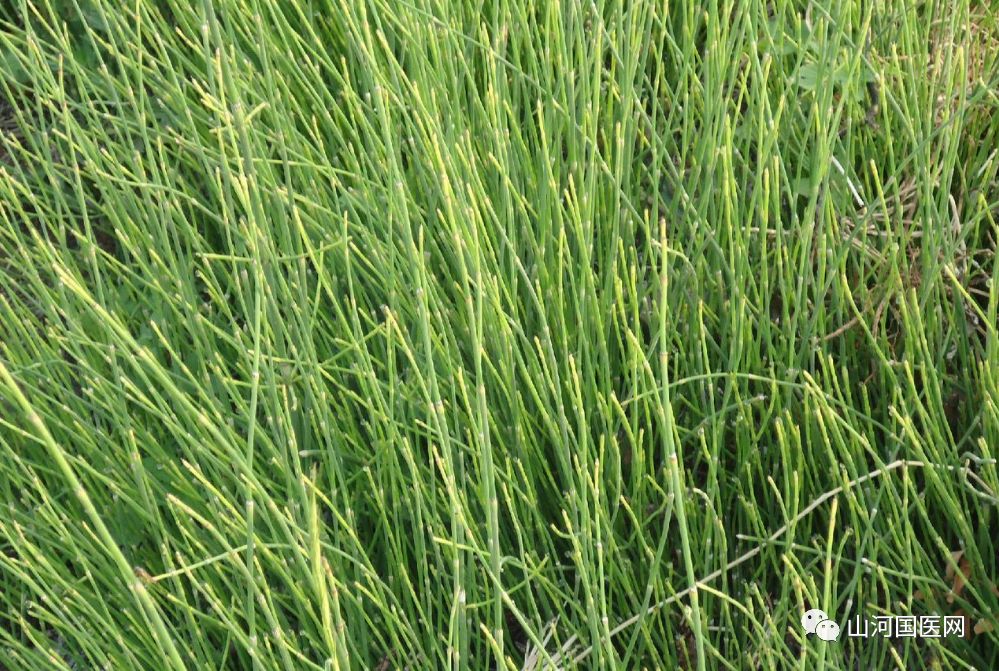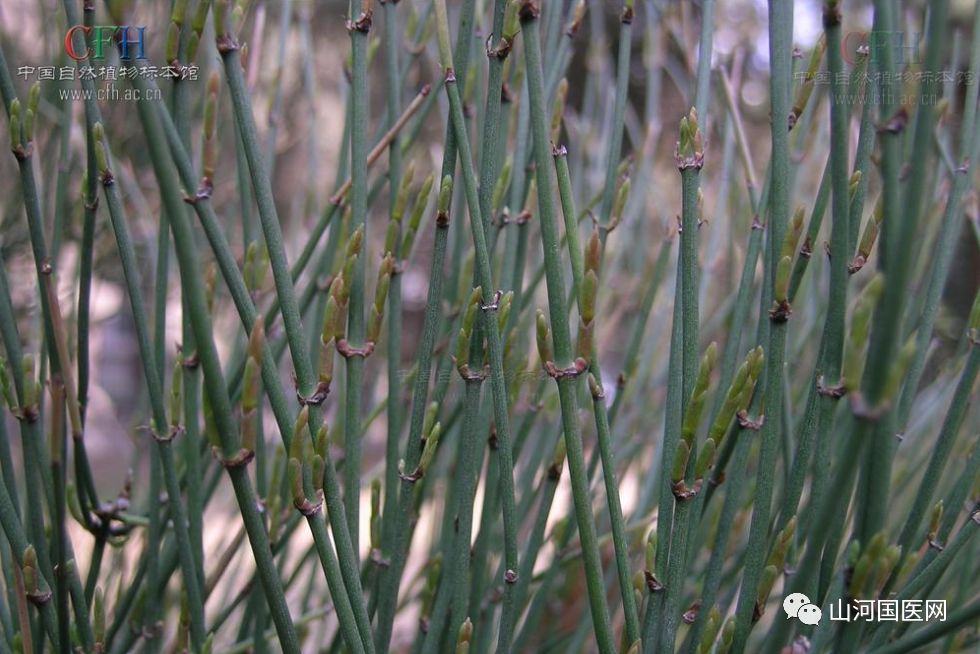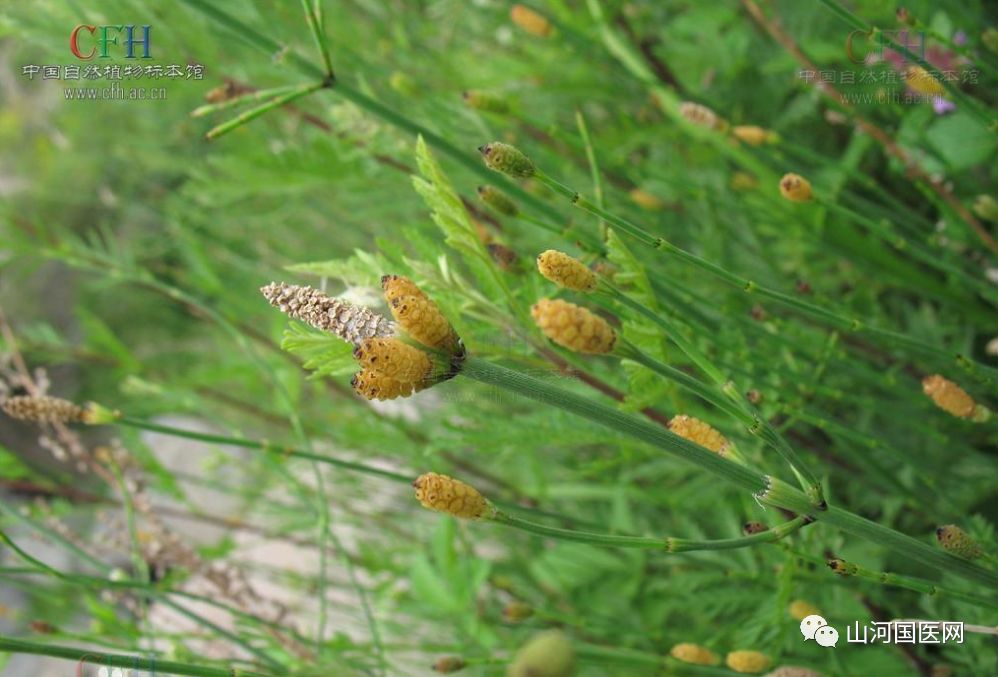| EquisetumMù Zéi | |
|---|---|
|
|
|
| Aliases | Chui Cao, Bi Tiao Cao, Bi Tong Cao, Jie Gu Cao, Mu Zai Cao, Jie Jie Cao, Ca Cao, Wu Xin Cao, Xiang Cao, Jie Gu Ye, Bi Gan Cao, Bi Guan Cao |
| Functions | Disperses wind-heat, clears eye cloudiness. Used for wind-heat eye redness, tearing in the wind, and cloudiness in the eyes. |
| First Recorded In | Jia You Ben Cao |
| Toxicity | Non-toxic |
| Meridians | Lung Meridian, Liver Meridian |
| Properties | Neutral |
| Tastes | Sweet, Bitter |
Li Shizhen said: “Mù Zéi has a warm nature, with a slightly sweet and bitter taste, hollow and light, yin within yang, it rises and floats. It resembles Ma Huang in shape and nature, thus it can also induce sweating and relieve muscle tension, dispersing fire and dampness, treating various blood disorders of the eyes.”
Overview
Mù Zéi[Source] First recorded in the Jia You Ben Cao. This herb has a segmented, rough surface, used for making wooden bones, and when rubbed, it becomes smooth and clean, hence the name ‘wood thief’.[Aliases] Mù Zéi Cao, Chui Cao, Jie Gu Cao, Wu Xin Cao, Jie Jie Cao, Ca Cao[Origin] This herb is the dried aerial parts of the plant Equisetum.[Harvesting and Storage] Harvest in summer and autumn, remove impurities, dry in the sun or shade, and store in a dry place for cutting into sections for use.[Morphology] The rhizome is short, brownish-black, and creeping; the nutritional stem and spore sacs are indistinguishable, mostly unbranched, reaching over 60 cm in height, with a diameter of 4-10 mm, the surface has 18-30 longitudinal grooves, rough, gray-green, with joints, the internodes are hollow, and the nodes have solid pith. The leaves are reduced to scale-like structures forming a tubular sheath at the base, with dark brown circles at the base and sheath teeth, the upper part is light gray, and the sheath has two to three ribbed spines forming shallow grooves. The spore sacs are borne at the top of the stem, elongated, without stalks, and have small pointed tips. This species originated in the Devonian period and was particularly prosperous in the Carboniferous period, with some species growing up to thirty meters high. Mù Zéi is a symmetrically structured plant, with a jointed stem and round leaves. Some species still exist today, but none exceed a few meters in height.[Habitat] Grows in moist shaded areas of slopes, riverbanks, and stream sides, preferring humid environments, sometimes found in weedy areas. Distributed in Heilongjiang, Jilin, Liaoning, Hebei, Anhui, Hubei, Sichuan, Guizhou, Yunnan, Shanxi, Shaanxi, Gansu, Inner Mongolia, Xinjiang, Qinghai, and other regions. Also found in other temperate areas of the Northern Hemisphere.[Characteristics] An annual or perennial herbaceous fern. The branch tips produce spore leaves, rectangular, pointed at the top, resembling a brush tip. The plant can reach 100 cm in height. The above-ground stem is single, unbranched, hollow, with longitudinal ridges, and has two rows of warty protrusions, very rough. The leaves form sheaths tightly wrapping the nodes, with a black circle at the top and base, and the teeth on the sheath are easily shed. Prefers moist conditions, tolerates shade, often found in damp areas on hillsides or under sparse forests. Potted plants need to be moved indoors during winter to avoid temperatures below 0°C.
Herbal Properties
The stem is long and tubular, unbranched. Length 40-60 cm, diameter about 6 mm. The surface is gray-green or yellow-green, with 18-30 fine longitudinal ridges, arranged straight, with two rows of small warty protrusions on the ridges, slightly rough to the touch. At the nodes, the sheath is formed by overlapping scale-like leaves, with two wider brown-black rings at the base and tip. The back of the sheath has two ridges and one shallow groove. The texture is brittle, easily broken, with a hollow cross-section. The edges have 20-30 small cavities arranged in a ring, containing white or light green thin pith. The aroma is slight, with a slightly astringent taste, and a sandy texture when chewed.
Indications
Disperses wind-heat, clears eye cloudiness. Used for wind-heat eye redness, tearing in the wind, and cloudiness in the eyes. This species is recorded in the Chinese Plant Atlas database as a toxic plant, with the entire plant being toxic. Horses that consume it may experience reflex excitability, difficulty walking, standing, and paralysis of the hind limbs, but appetite and neurological activity remain normal until late stages. Acute poisoning can lead to death within hours to a day, while chronic poisoning from long-term small amounts can cause weight loss and diarrhea. Anatomical findings show congestion and edema in the cerebellum and spinal cord. Properties: Sweet, Bitter, Neutral. Enters the Lung and Liver Meridians. 1. Disperses wind-heat, brightens the eyes, and clears cloudiness: indicated for external wind-heat causing red, watery eyes and cloudiness. 2. Stops bleeding: used for blood in stool and hemorrhoidal bleeding.
Dosage and Administration
For internal use, decoct 3-9g, or use in pills or powders; for external use, grind into powder and sprinkle. Caution is advised for those with qi deficiency or blood deficiency eye disorders.
Selected Formulas
1. Mù Zéi San (from Zheng Zhi Zhun Sheng) for treating red eyes and cloudiness: Mù Zéi, Chan Tui, Gu Jing Cao, Gan Cao, Cang Zhu, She Tui, Huang Qin. Decoction for oral administration. Mù Zéi in this formula disperses wind-heat and clears eye cloudiness, serving as the monarch herb. 2. Mù Zéi San (from Ren Zhai Zhi Zhi Fang) for treating intestinal wind and blood in stool: Mù Zéi (remove nodes, stir-fried) 30g, Mu Fan (stir-fried), Zhi Ke (processed), Huai Jiao (stir-fried), Fu Ling, Jing Jie each 15g, grind into powder, take 6g with concentrated jujube decoction. Mù Zéi disperses wind-heat, serving as the monarch herb. 3. (from Sheng Ji Zong Lu) for treating restless fetus: Mù Zéi (remove nodes), Chuan Xiong in equal parts. Grind into powder, take 9g with 1 cup of water, add 3g of Jin Yin Hua for decoction. Mù Zéi disperses wind-heat, serving as the monarch herb.
Commentaries
1. Bencao Gangmu: Mù Zéi, similar in shape and nature to Ma Huang, can also induce sweating, relieve muscle tension, disperse fire and dampness, and treat various blood disorders of the eyes. 2. Bencao Jing Shu: Mù Zéi primarily treats eye disorders and clears cloudiness, benefiting the liver and gallbladder, and brightening the eyes. It also treats accumulations, intestinal wind, diarrhea, and women’s menstrual issues, all related to blood and liver function. 3. Bencao Feng Yuan: Mù Zéi specializes in wind-heat eye disorders, acute cloudiness, and tearing, dispersing liver and lung wind pathogens. 4. Bencao Qiu Zhen: Mù Zéi is noted for its similar properties to Ma Huang, but it is not pungent and hot, entering the Shao Yang Gallbladder and Jue Yin Liver meridians, dispersing wind-heat in the blood, allowing blood to reach the eyes, thus effectively clearing cloudiness. It is not as effective as Gu Jing Cao or Gan Ju for treating starry obstacles, but it can clear cloudiness effectively. However, if there is qi and blood deficiency, it should be used with Gu Jing Cao and supplemented with Shao Yao and Shu Di to nourish the liver and kidneys, ensuring the eyes receive sufficient blood for vision. If only these two herbs are used to clear cloudiness, it is advisable to add Dang Gui for support, as the pungent and dispersing nature may not be suitable. 5. Bencao Zheng Yi: Mù Zéi treats liver and gallbladder wood disorders, clears eye cloudiness, and alleviates accumulations, serving to dissolve excess. It is a key herb for eye conditions, not only for its ability to clear cloudiness but also for its functions in dispersing wind, draining damp-heat, and relieving stagnant fire. It treats throat obstruction, blood dysentery, bleeding, hemorrhoids, menorrhagia, and hernias, all related to qi stagnation and blood stasis, and liver depression. Mù Zéi’s function is to relieve stagnation and disperse heat, addressing these conditions effectively. It is important to note that its strong clearing ability is suitable for treating blood in stool, blood dysentery, menorrhagia, and hemorrhoids, but caution is needed for those with qi deficiency, as many cases of blood dysentery, blood in stool, and menorrhagia are due to qi deficiency and blood not being able to be contained. 6. Jia You Ben Cao: Primarily treats eye disorders and clears cloudiness. It also dissolves accumulations, benefits the liver and gallbladder, brightens the eyes, treats intestinal wind, and stops diarrhea, as well as women’s menstrual issues. 7. Bencao Gangmu: Relieves muscle tension, stops tearing, stops bleeding, dispels wind-dampness, treats hernia pain, and rectal prolapse. 8. Bencao Zheng Yi: Induces sweating, relieves muscle tension, treats febrile diseases and malaria, dispels wind-dampness, and scatters fire evils. 9. Wang Jiu Yao Jie: Treats swelling and hardness of sores, expels wind and phlegm. Treats carbuncles, abscesses, and other conditions.
Pharmacological Effects
The silicates and tannins contained in Mù Zéi have astringent effects, leading to anti-inflammatory and hemostatic actions at the contact site. The entire herb of Equisetum arvense has diuretic effects; it has been clinically used to treat diabetes, but animal studies have not confirmed this. Livestock consuming Mù Zéi and related plants can experience poisoning, with symptoms including limb weakness, ataxia, difficulty turning, tremors, and muscle rigidity during activity, weak and rapid pulse, cold limbs, and blood chemical analysis indicating vitamin B deficiency, with large doses of vitamin B having a detoxifying effect. 1. Cardiovascular effects: Mù Zéi ethanol extract can increase coronary blood flow in isolated guinea pig hearts. A dose of 0.2ml/kg (100% extract) intravenously has a certain antagonistic and buffering effect on T-wave elevation and heart rate slowing induced by posterior pituitary hormone. Mù Zéi ethanol extract at doses of 10-15g/kg intraperitoneally or 20g/kg orally has a lasting hypotensive effect on anesthetized cats. The intensity and duration of hypotension correlate with the dose. It can also counteract histamine-induced vasoconstriction, and still has hypotensive effects in cats with severed spinal cords, indicating a peripheral site of action. It has a significant dilating effect on isolated rabbit blood vessels. 2. Other effects: Ferulic acid inhibits platelet aggregation and release; in animal experiments, it has sedative and anticonvulsant effects, with a median lethal dose (mg/kg) of 946 for intraperitoneal injection in mice and 3000 for oral administration in rats. Toxicity manifests as ataxia, muscle rigidity, and cold limbs. Blood analysis indicates vitamin B deficiency, and treatment with large doses of vitamin B can restore normalcy.Disclaimer: The content on this site is added and organized by users for learning and reference purposes. The information on the site may not be accurate, comprehensive, or up-to-date, and the content should not be considered the final basis for diagnosing or treating diseases.Shanhe Traditional Chinese Medicine Network reminds users that if you experience any discomfort, please seek medical attention promptly. Thank you for your support and love; we will strive to do better~!!!


